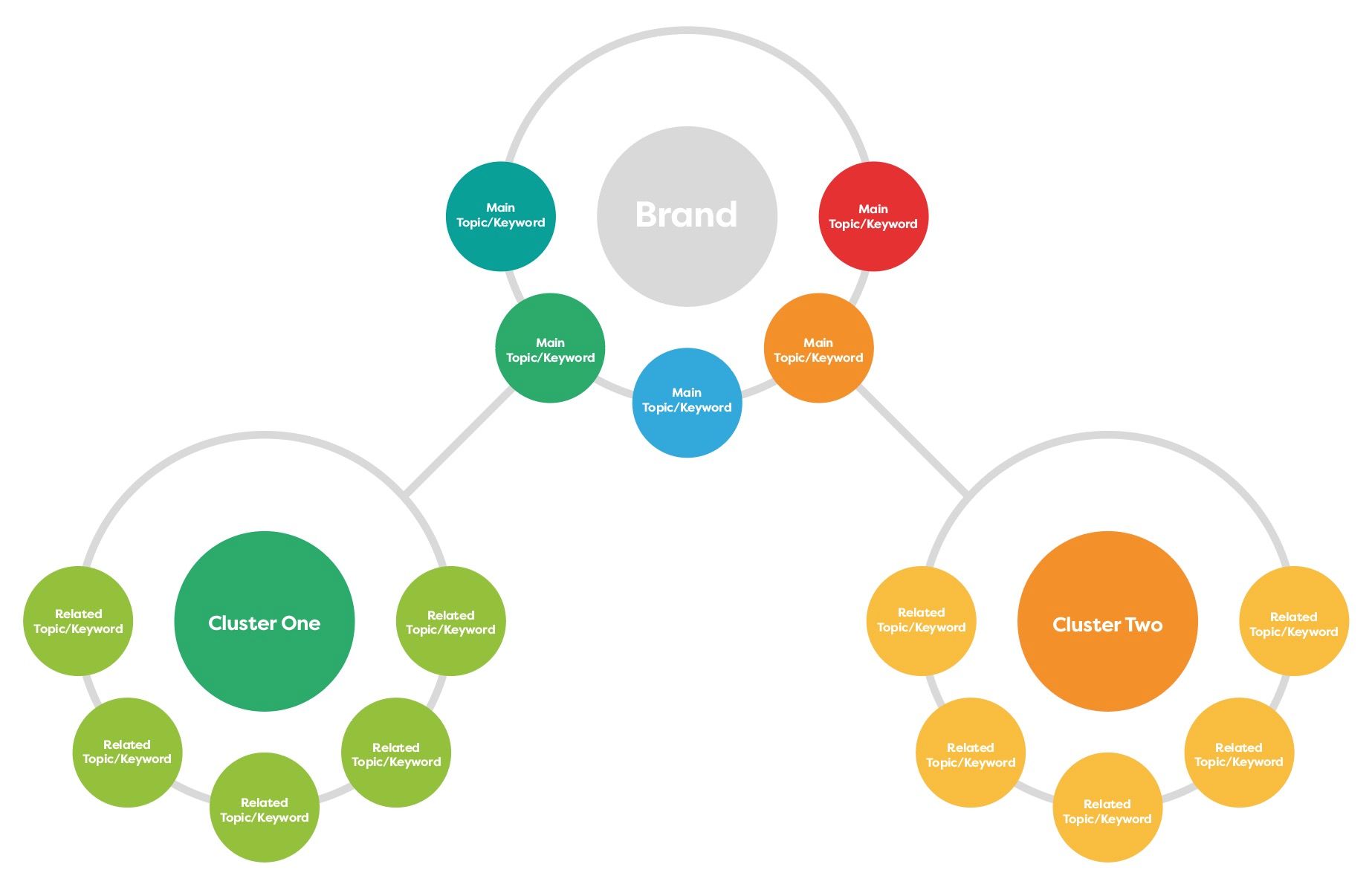Everybody loves a good cluster strategy—brands, content marketers, users, and search engines. And for good reason; when planned and implemented well, it can drive huge performance.
However, not everybody knows how to build them right.
Learn how to create topic clusters successfully with these best practices.
What is a cluster strategy?
A cluster strategy in content marketing is an SEO tactic that creates a network of content based on a main topic and its subtopics. This network is called a “topic cluster,” which connects interrelated content with internal links.
Content for the core topic is the “pillar page,” whereas content for related topics and subtopics are called “cluster posts.”

10 Best practices to create a content cluster strategy
Here are ten best practices to remember when creating a content cluster strategy:
1: Build a HUGE list of subtopics
Conduct thorough content research to build an authoritative and exhaustive topic cluster. Don’t give your target audience a reason to look elsewhere for the information you didn’t include.
Use tools like Semrush to expand your main topic into a long list of related subtopics.
On the Keyword Magic Tool, enter the focus keyword for your main topic. Use short-tail keywords like “habit stacking,” “mental fitness,” and “pet care” to uncover truckloads of subtopics.
Scan the keyword search results for potential ideas around your particular topic. Look for “informational” keywords that people use to do online research.
Semrush indicates information keywords with an ‘I’ under the “Intent” column.
For more subtopic ideas, click ‘Questions’ to reveal question-based keywords. These are content ideas that directly relate to your target audience’s problems.
Explore phrase match, exact match, and related keywords for more ideas. These categories pull up different keyword variations for a diversified topic cluster.
You can also use AnswerThePublic to discover keywords that Semrush may have missed. It’s a free content ideation tool that compiles queries from search engine results pages—perfect for creating topic clusters without content gaps.
Start with a broad keyword or topic and click ‘Search.’
AnswerThePublic offers five keyword categories that can supply you with subtopic ideas.
Tip: Check these keyword categories using the “Data” view for better readability. Simply switch to the ‘Data’ tab above the keyword results.
2: Conduct competitor analysis
Make sure your topic cluster is built to compete with competitor analysis.
Use Google to find the top-ranking websites for your focus keyword. In most cases, you’ll find additional subtopics right from the search engine results.
Do an eye test of the top results and look for pillar pages. These will give you a goldmine of subtopics to add to your topic cluster.
For example, the pillar page from RSPCA links to subtopics you can include.
Other than subtopic ideas, competitor analysis also lets you find keyword opportunities with a tool like Semrush.
Launch the Domain Overview tool and plug in the URL to your competitor’s page.
On the domain overview report, scroll to the “Organic Research” column and look at the “Top Organic Keywords” list. Consider adding these keywords to your topic cluster strategy if you haven’t yet.
3: Optimise your cluster content’s loading speed
A digital.com survey revealed that 50% of users abandon a website that doesn’t load in six seconds or less.
That’s half of your potential traffic out the window.
Some other data sources suggest that six seconds might actually be three seconds.
Scan your topic cluster content for performance-related issues with a tool like PageSpeed Insights. Just enter the URL of your pillar page or cluster post, then click ‘Analyze.’
The report begins with a diagnosis of your page’s performance on mobile and desktop devices. Use the tabs above to switch platforms.
If your performance rating is less than 90, review the “Opportunities” and “Diagnostics” sections below. These will show you the detected issues bogging down your website’s loading speed.
Click on any issue to reveal more details along with remediation suggestions.
For example, if PageSpeed Insights reveals that third-party code is affecting loading speed, it will highlight the third-party integrations responsible.
Click ‘Learn more’ for in-depth instructions on how to fix performance-related issues on your website. These may require coding knowledge, but their impact can be offset with the right performance optimisation plugins, tools, and services, like:
- W3 Total Cache
- WP Rocket
- Autoptimize
- CDN services (Cloudflare, Google Cloud CDN, Amazon CloudFront, etc.)
4: Don’t go overboard with your pillar page
Pillar pages are meant to help users find the specific blog post for a subtopic. They’re not supposed to spill more detail than cluster posts.
If users want to explore a subtopic, prepare them with basic information and a quick introduction. Write short paragraphs to ensure they easily find the link to the associated cluster post.
Write a simple and concise pillar page that makes it easier to find internal links. Pique their interest with quick tips and explanations relevant to the subtopic, but that’s it.
For most topics, 2,000 words should be plenty for a pillar page.
To target the right word count, check the average length of the top 10 results for your topic or subtopic keyword.
Alternatively, use an on-page optimisation tool like Surfer SEO to get real-time content length suggestions. It also provides suggestions for keywords, headings, and image count through machine learning.
5: Streamline your content development process
Consistent content development is the most time-consuming phase of building a topic cluster.
Don’t let it bottleneck your cluster strategy.
Use automated writing apps to streamline tasks like proofreading, editing, and optimisation.
Grammarly is the go-to writing assistant for marketers, bloggers, students, and everyone who needs to create sparkling content. It generates real-time correction suggestions based on your specific content goals.
To polish content with Grammarly, paste your pillar page or cluster post draft into the editor.
The writing assistant immediately shows suggestions that affect your content’s correctness, clarity, engagement factor, and delivery.
Grammarly can also be used as a Microsoft Word add-on, Google Chrome extension, or standalone desktop app. If you create plain text content, you can also write your draft straight from the Grammarly editor.
Apart from Grammarly, here are other writing tools to streamline cluster content creation:
- Writesonic: An AI-powered writer to lighten the load of content creation.
- Headline Studio: A free tool from CoSchedule to help you write click-worthy headlines.
- Hemingway Editor: Another free tool to simplify your writing and improve readability.
6: Interlink as many related pages as possible
Internal links make the most out of organic traffic by giving readers more content to explore. They also help search engine crawlers explore your site and understand your content hierarchy, which can boost rankings.
Topic clusters give you ample opportunities for internal links.
In addition to links to and from your pillar page, cluster posts can also link to each other based on topical relevance.
Use Surfer SEO’s content audit tool to discover missed internal link opportunities.
Go to the Audit tool and enter your cluster post’s URL along with its focus keyword.
The content audit report shows on-page optimisation opportunities regarding backlinks, keywords, metadata, and so on. It also identifies topically relevant pages that can be internally linked from your cluster post.
Click ‘Show internal links’ to reveal these pages.
Look specifically for other cluster posts from within the same topic cluster. If you find existing content that’s outside the cluster, use your discretion on whether it needs an internal link.
7: Make mobile-friendly cluster content
Research shows that mobile users now account for the majority of internet traffic.
Most users may not have an engaging experience if you develop a pillar page without mobile optimisation. Search engines like Google also consider mobile-friendliness a crucial ranking factor.
To optimise your cluster content for mobile, below are four simple tips to try:
- Use responsive design to scale page elements and reposition based on the device’s display.
- Space out clickable/tappable elements.
- Use larger fonts and image sizes.
- Develop an app to make your topic cluster content more accessible.
- Improve your website’s loading speed on mobile devices.
If you have already developed your cluster content, use the Mobile-Friendly Test to find ways to boost the experience of mobile users.
Mobile-Friendly Test detects problems and provides solutions to help optimise pages for mobile users.
On the results page, click on a problem to view technical details. For in-depth instructions, click the ‘Go to issue documentation’ button.
8: Build multiple topic clusters
Authoritative brands use multiple topic clusters—one for each content category on their website.
A lifestyle blog, for example, can create clusters for related topics like fashion, food, and outdoor activities.
If your blog is focused on a small topic, build different types of pillar pages that connect to similar cluster posts. Set a unique theme for each pillar page, such as:
- FAQs. Create a pillar page that links to question-based cluster content (“how-to” guides, “what is” posts, etc.).
- Resources. Compile cluster posts that discuss tools, services, and other resources on a single pillar page.
- Press. Build a pillar page for news-type articles, press releases, and other cluster posts that relate to your company.
9: Amplify your topic cluster with link building
Topic clusters work best when paired with a solid link building strategy.
Every piece of content in your topic cluster should receive a healthy amount of backlinks. These will happen naturally if you produce great content, but sometimes it needs a push.
Pillar pages are a given since they spread traffic and link equity to all other posts in the cluster. Meanwhile, backlinks to cluster posts allow faster rankings because they can target low-difficulty keywords.
Some of the proven link building strategies are:
- Guest posting. Submit articles to authoritative sites that publish guest posts and include a link to your cluster content. Make sure the website is genuine and of high quality.
- Mention other brands. Link to other brands in your cluster content and notify them to encourage a backlink.
- Steal backlinks from competitors. Check your competitor’s backlink sources, reach out to them, and give a compelling reason to link to you instead.
10: Use a content tracking platform
Pillar pages and cluster posts affect the effectiveness of the entire topic cluster.
Deploy a content tracking system with a platform like Google Analytics. This lets you monitor content performance and make the necessary adjustments to improve the user experience.
Google Analytics tracks metrics like session duration, pages per session, bounce rate, and conversion rate. It also identifies your top-performing pages, which lets you shape your content strategy over time.
FAQs for creating a cluster strategy
FAQ 1: How do content clusters strengthen SEO?
Topic clusters improve the crawlability of your website content, which is essential to the indexing process. They also build topical relevance and elevate the user experience.
FAQ 2: What is a topic cluster strategy?
The topic cluster strategy groups content around a main topic using a pillar page. This page links to more detailed posts that discuss relevant subtopics.
FAQ 3: How do I create a content cluster?
Five steps on how to create topic clusters:
- Choose your main topics and subtopics
- Perform keyword research
- Create a topic cluster content plan
- Analyse competitors’ pillar pages
- Find missed internal link opportunities
Create high-performing cluster strategies now
Topic clusters bolster your website’s content architecture, improve the user experience, and increase your search engine rankings.
But effective topic clusters aren’t easy to make.
Let my team help with your topic cluster strategy by sending a message here. Get expert help planning your topic cluster, creating content, and optimising each piece for maximum SEO results.






